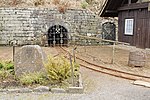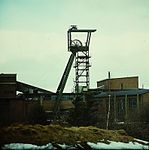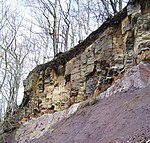Harz region
The Harz mining region is an industrial cultural landscape that has developed over 1000 years in the northernmost German Central Mountains, which today forms the border region between the three German federal states of Lower Saxony , Saxony-Anhalt and Thuringia . It is characterized by a large number of historically largely original technical monuments, as well as numerous individual monuments and aggregates related to the mining industry . The identity and authenticity of the montane cultural landscape of the Harz is comparable to the mining region of the Erzgebirge , which has been part of the UNESCO World Heritage since 2019 .
In 2010, the ore mine Rammelsberg near Goslar, the Upper Harz water management including the Walkenried monastery , the former Samson mine and Goslar's old town were awarded the UNESCO World Heritage title in the Harz mining region .
history
The mining of non-ferrous metals and silver in the Harz dates back to the Bronze Age. Analyzes that were carried out on found slag and unsettled ore chunks from the manor house in Düna in the southern Harz confirm that iron ore was smelted from Bad Grund in the first century , as well as from Upper Harz and Rammelsberg ores in the third century AD.
As early as 968, mining on Rammelsberg was first mentioned in writing in the Res gestae Saxonicae by Widukind von Corvey . According to this chronicle, Otto the Great "opened silver veins in the Sachsenland" ("in Saxonia venas argenti aperuit"). In the old camp in 1999 remains of a leather shoe found that are dated to the 1024th Also in the underground of the old camp a wooden construction was discovered in 2011, which is said to be the oldest wood-secured tunnel in Central Europe to date. From that time on, mining continued uninterrupted in the Harz until after 1990. The mined raw materials included silver , tin , zinc , cobalt , nickel , copper and lead , but also hard coal . Mining was an important motor for the numerous small states that existed in the Harz Mountains and made a significant contribution to an economic boom in this mining region.
Show mines in the Harz Mountains
| Surname | state | local community | comment | location | image |
|---|---|---|---|---|---|
| Knesebeck shaft | Lower Saxony | Bad Grund (Harz) | Pit help of God, lead, zinc, silver, mine extraction | location |

|
| Scholmzeche | Lower Saxony | Bad Lauterberg in the Harz Mountains | Lead, zinc, iron | location |

|
| Dorothea's pit | Lower Saxony | Clausthal-Zellerfeld | Silver , galena ; Contact: Upper Harz Mining Museum | location | |
| Rosenhof pit | Lower Saxony | Clausthal-Zellerfeld | underground bike rooms , world heritage, contact: Upper Harz Mining Museum | location |

|
| Rammelsberg visitor mine | Lower Saxony | Goslar | World Heritage | location |

|
| Lautenthals Glück mine for visitors | Lower Saxony |
Langelsheim , OT Lautenthal |
Galena , zinc blende ; underground navigable waterway, almost 100 m long navigable | location |

|
| Catharina Neufang pit | Lower Saxony | Sankt Andreasberg | Lead, silver, mining expansions; Access via Samson Pit | location | |
| Red Bear mine training mine | Lower Saxony | Sankt Andreasberg | former iron ore mine; Great importance is attached to the best possible preservation of the original condition; also serves to produce drinking water | location |

|
| Samson Pit Visitor Mine | Lower Saxony | Sankt Andreasberg | last functional driving art in the world, world cultural heritage | location |

|
| Wennsglück pit | Lower Saxony | Sankt Andreasberg | Silver, copper pyrites, cobalt; Operation as part of the training mine Red Bear mine | location |

|
| 19-Lachter-Stollen | Lower Saxony | Wild man | Lead, zinc, hydropower | location |

|
| Strassberg mining museum with Glasebach pit | Saxony-Anhalt |
Harzgerode , OT Straßberg |
Fluorspar | location |
|
| Büchenberg show mine | Saxony-Anhalt |
Oberharz am Brocken , OT City of Elbingerode (Harz) |
iron | location |

|
| Visitor mine Drei Kronen & Ehrt | Saxony-Anhalt |
Oberharz am Brocken , OT City of Elbingerode (Harz) |
former pit pyrite unit; Visitor mine closed from November 1st, 2015 | location |

|
| Röhrigschacht show mine | Saxony-Anhalt |
Sangerhausen , OT Wettelrode |
former copper slate mine | location |

|
| Rabensteiner Stollen visitor mine | Thuringia |
Harz gate , OT Ilfeld |
Hard coal mine in the Harz Mountains | location |

|
| Lange Wand visitor mine | Thuringia | Harztor, OT Niedersachswerfen |
Copper slate | location |

|
Mountain areas
The Mansfelder and Sangerhäuser Revier, in which copper slate in particular was mined for more than 500 years, are among the most important mountain areas in the southeastern Harz. One of the most important coal and steel entrepreneurs there was Mansfeld AG . In these two mountain areas, an extremely large number of technical monuments from the centuries-old mining history of the Harz region have been preserved.
Series of publications
Since 2001 the German Mining Museum Bochum has published the book series Montanregion Harz , the authors of which include numerous well-known mining scientists. Thirteen volumes of this series have already appeared in print.
Working group
The project group "Montanregion Harz" of the Historical Commission for Lower Saxony and Bremen, headed by Dietrich Denecke since 2007 in succession to Karl Heinrich Kaufhold , also bears this name. This working group meets regularly twice a year to exchange the latest research findings from the Harz region.
See also
literature
- Manfred Rasch : Harz. A coal and steel region in transition , Klartext Verlag, Essen 2008, ISBN 978-3-89861-809-0 .
- Karl Heinrich Kaufhold , Ekkehard Westermann and Hans-Jürgen Gerhard : European Montanregion Harz (= Montanregion Harz. Vol. 1 = Publications from the German Mining Museum Bochum. Vol. 98). German Mining Museum, Bochum 2001, ISBN 3-921533-83-X .
Individual evidence
- ↑ Lothar Klappauf et al .: On the trail of an early industrial landscape . Lower Saxony State Office for Monument Preservation, Hameln 2000.
- ↑ Series of publications Harzer Montanwesen
- ↑ Klaus Fehn, Anngret Simms (Ed.): Ways of historical geography and cultural landscape research. Selected articles on the occasion of Dietrich Denecke's 70th birthday. Steiner, Stuttgart 2005, ISBN 3-515-08680-3 .

